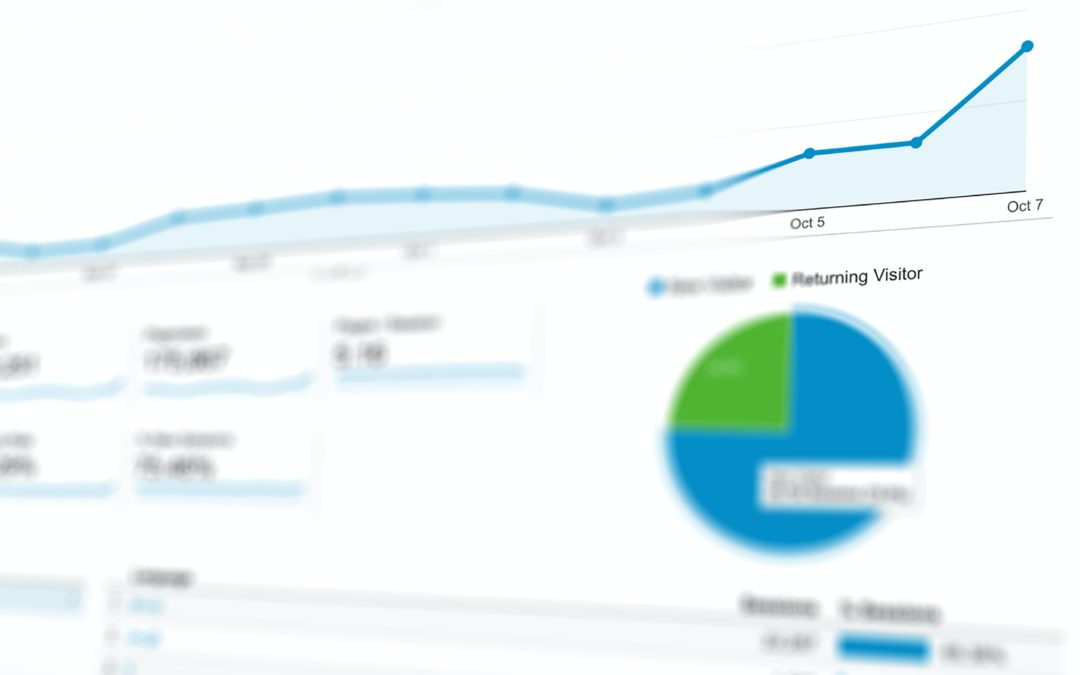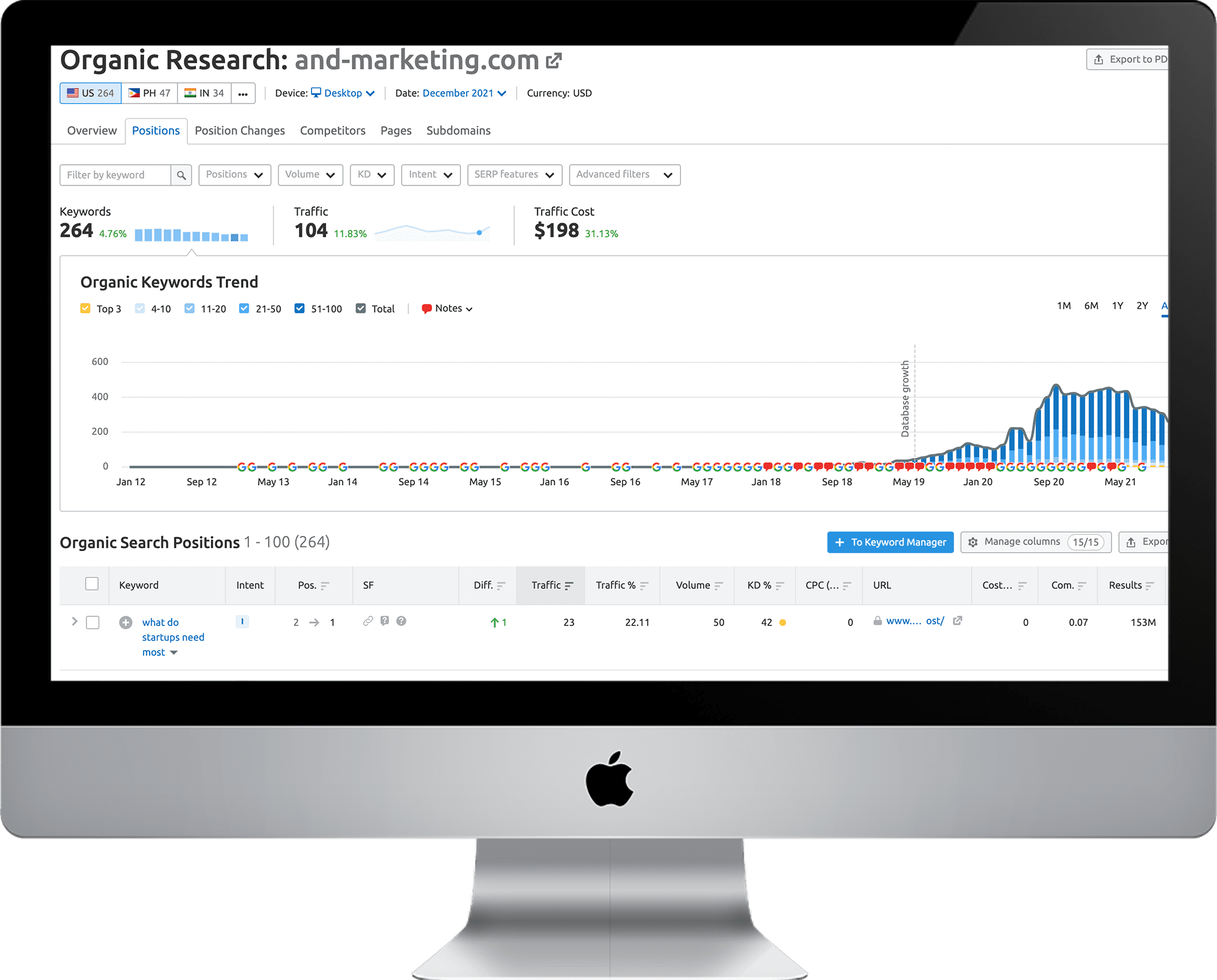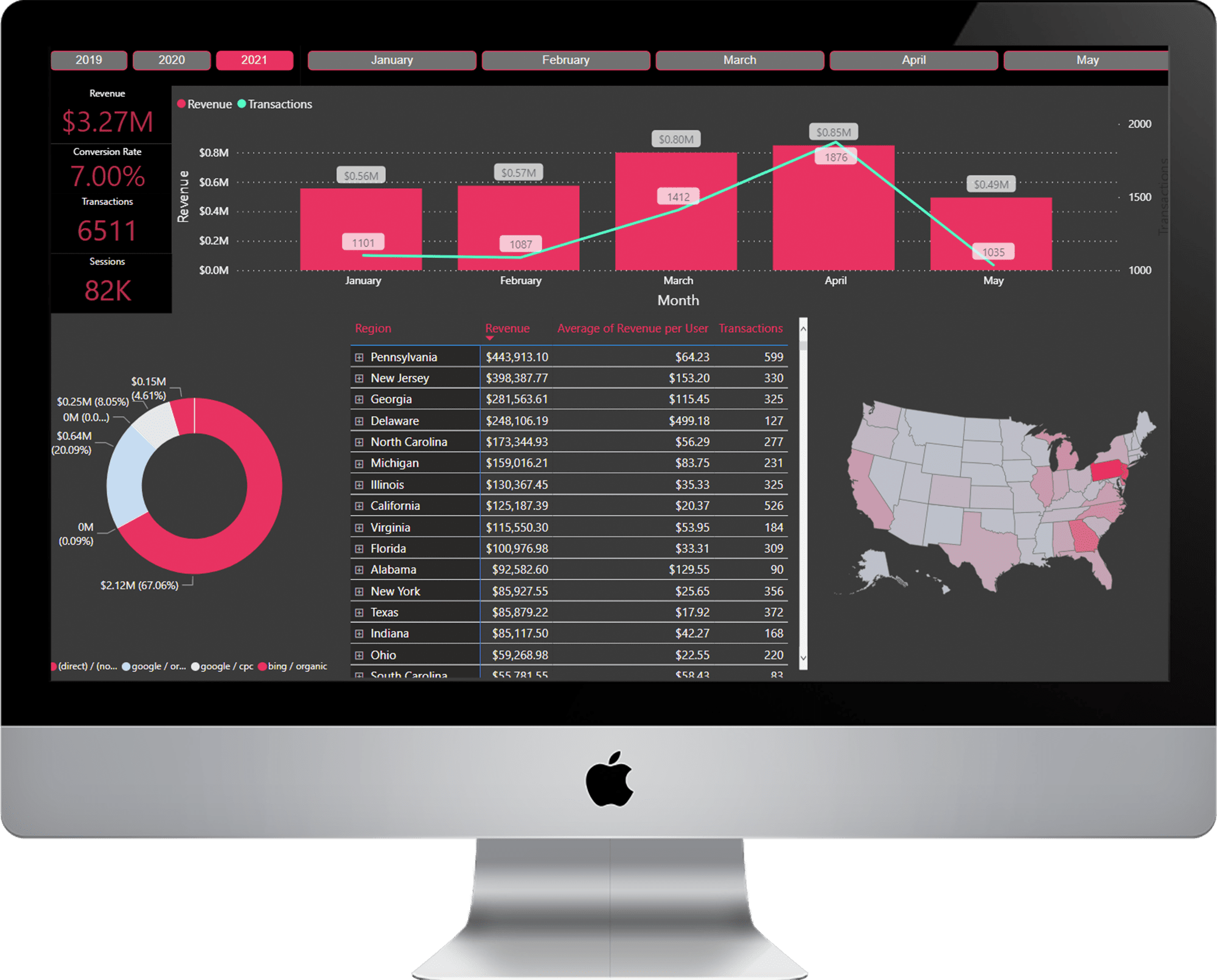All of the marketing trends with none of the industry jargon.
Sign up for our newsletter to stay updated on best practices, actionable tips, and virtual events so you can grow your business like a marketing pro.


Big data is hard to collect, organize, and view at scale, but you know you need it to compete in today’s growing digital landscape.The way you’re analyzing data now is likely a time-eating process that hardly ever results in quality business insights. It’s difficult to move beyond massive Excel spreadsheets, but it’s also daunting to invest in sophisticated tools that aggregate data but don’t integrate with one another. Telling a story through data pulled this way that can actually inform your business decisions is nearly impossible.
In order to remain digitally relevant, you must implement a solid business intelligence strategy that simplifies the ability to make business decisions from loads of data. In this blog, we discuss three ways business intelligence (BI) can form your business strategy for immediate success.
A business intelligence strategy is the process of developing and executing a BI system that will help identify opportunities and weaknesses that give your business a roadmap for achieving business level goals.
A BI strategy will help you make informed strategic decisions, save time and money, and gain a competitive edge. Implementing a BI strategy is not an easy task: it requires significant preparation and, potentially, expenses. In the end, though, the rewards (and ROI) will outway the costs. And soon, businesses that don’t BI will experience higher costs long term than those that do. Once the automations and aggregators are set up behind the scenes, you can cut the time it takes to manually pull, align, and analyze data manually by up to 90%.
A solidified BI strategy uncovers where your business is maximizing ROI while also identifying the business actions not giving you a return on your investment. It’s difficult to analyze ROI across business campaigns, most often due to unstructured data coming from multiple data sources that do not talk to each other. The information in these disparate systems may be easy to report on in a siloed view; however, a siloed view limits the ability to compare the real impact (or lack thereof) of a specific campaign. By implementing a BI strategy, CEOs and business owners can review data combined from multiple sources and see insights at the business level to fully understand what’s performing and what’s not.
BI can simplify the data collection process, which can reduce your long term costs for gathering data on an ongoing basis. Budgeting and forecasting can also be accomplished through a solid BI strategy. CEOs and business owners can estimate how much they need to spend on certain campaigns in order to achieve their business revenue goals with campaign-specific performance data. Additionally, they can quickly identify where campaigns are blowing through budget without producing results and take immediate action to either stop or reroute budget elsewhere.
Outgoing campaigns are not the only area where you can use BI to optimize your costs. At &Marketing, we use it internally to understand how we are spending our time for each of our clients and identify where we can improve our own execution processes to optimize time and reduce costs.
By implementing a business intelligence strategy, you can get visibility into your entire competitive landscape across multiple business lines and channels. Competitor intelligence is often difficult to work into existing analytics, as competitor data does not always match up apples to apples with your own data. If you’re struggling with limited competitor information, BI tools are available that can analyze competitor campaigns by identifying where they are doing better and what areas you can improve and overtake them.
Creating and executing a business intelligence strategy is not an easy task. It requires extensive planning and is not as easy as simply choosing a platform. Here’s what to know:
The most important part of creating a business intelligence strategy is to define KPIs for your business. Without KPIs, you will develop a strategy that does not effectively answer the questions you need to answer.
After defining your KPIs, understand the people, processes and technologies you need in order to achieve success. This step is important in getting everyone on the same page before getting too far down the road.
This is the most time-consuming step of creating a business intelligence strategy. You must gather all of the data and determine common connectors so it all communicates. Once you have aligned data sources, be sure to visualize the data in a way that CEOs and business leaders are able to easily understand.
This is the most exciting part of creating a business intelligence strategy and a critical step in taking data all the way from insights to action. Our team recommends reviewing data for multiple time frames in order to best understand your business. For example, compare months, quarters, and years to uncover trends. September might show higher numbers than October, but you might be up for the quarter or the previous year’s September.
Using the business insights from above, create a roadmap for success that details your campaigns. Use the roadmap to guide your tactics and serve as a baseline. After starting the campaigns, be sure to monitor results as soon as you have them.
Business intelligence strategies are always evolving, just as new digital tools arrive to market every day and online trends ebb and flow. Be sure to constantly review the market for ways to innovate.
Implementing a BI strategy requires upfront work and expense that your business will need to prepare for ahead of time. Yet, a solidified BI strategy uncovers where your business is maximizing ROI while also identifying the business actions not giving you a return on your investment.
Having trouble with building your BI strategy? Download Our BI eBook to help you pave a roadmap for your own business.
Marketing Director Paul Ferguson helps clients develop fully integrated marketing solutions that make impressions and drive results. Whether it be design-oriented campaigns or digital market execution, Paul skillfully creates strategies to effectively reach client’s desired audiences.
&Marketing provides the robust outsourced marketing department growing companies need without the high overhead costs of big agencies or full-time employees. Our variable model empowers businesses to reach their growth goals through access to the guidance and expertise of senior level strategists and a flexible execution team.
Are you facing challenges of your own in generating leads and meeting your business’ growth goals?
We’d love to learn more about your challenges and how a coordinated marketing approach might help take your organization to the next level.


We’re all full of uncertainty as we map out the next year, but you don’t have to worry about drowning in doubt. With a solid plan and strategy in place, you can do more than just tread water. You can swim past the competition.
With today’s rapidly changing business landscape, 2023 planning can feel paralyzing at worst and daunting at best. From rising inflation and operating costs, to employee retention and supply chain gaps—chances are you’re sitting down to plan for 2023 and finding yourself at a loss.
The good news is, planning for growth in 2023 doesn’t have to be overwhelming, stress provoking or confusing. With advice from the leading experts in business and marketing, you can equip yourself with the knowledge, tools and action steps to prepare yourself for an uncertain 2023 and position your business not just to tread water, but to swim faster and stronger than your bigger competitors.
What’s their secret? We’ll let them tell you. Our network of business and marketing leaders shared their top challenges and best tips on navigating uncertainty. Our experts will discuss the trends and provide a roadmap to grow in 2023.
Our Founder & CEO, Rajat Kapur and trusted industry CMOs Alan Gonsenhauser, Danielle Cantin and Jennifer Garcia who each bring 20+ years of business and marketing leadership, teach you:
As the Founder and Managing Director of &Marketing, Raj strives to provide growing businesses of all sizes unparalleled marketing strategy and execution services. Raj brings two decades of professional experience in marketing, sales, and strategy development experience spanning B2B and B2C Fortune 50, mid-sized, and startups.
Alan Gonsenhauser, Founder and Principal of Demand Revenue, is an experienced CMO and general manager, and more recently as a CMO Executive Advisor and Analyst at Forrester and SiriusDecisions. He now offers Interim / Fractional Marketing Leadership, CMO Executive Advisory and Coaching, and Keynote Presentations, bolstered with comprehensive Strategic Marketing Services.
Danielle Cantin is an award-winning creative, mentor, and strategic branding and marketing expert. She helps companies reconnect with the Soul of their Brand so they can uncover missing pieces and achieve the deeper brand alignment needed for ultimate profits and success. Honored with the Vanguard Award for Innovation in Communication and a Cannes honorable mention for her work with Mazda, Danielle is a lifelong seeker, bringing the highest tools and teachings to her clients so they can break through to the next level.
Jennifer Garcia, CEO of Red Bamboo Marketing, brings a wealth of industry experience and an entrepreneurial spirit to lead an agency that blends marketing strategy, technology and creativity to drive genuine growth for clients. In her most recent role as Director of Marketing for Visual Lease (SaaS financial services), she drove 150% ARR growth during her tenure. She recently partnered with &Marketing to offer Interim / Fractional Marketing Leadership to growing businesses.
In today’s fast paced world, many growing businesses are struggling to modernize their marketing approaches because either they don’t have the expertise or the bandwidth to do it themselves.
&Marketing provides seasoned marketing strategy professionals and a nimble execution team to help our clients achieve their goals. Our unique partnership model allows us to augment our client’s existing teams or outsource the entire marketing function in an affordable, flexible, and transparent way.


With detailed market intelligence and a solid content strategy, you can compete with your Goliath competitors for your buyers’ attention without spending all of your marketing budget on Google ads.
75% of people don’t click beyond the first page of Google when they search for help or answers online. Your larger competitors are ranking first and second organically and have the biggest share of voice online. On top of that, it’s likely the content you are creating isn’t answering the questions or solving the problems your buyers and customers are experiencing.
These obstacles are preventing you from beating those competitors and getting your target customers to visit your site and see your offers instead might feel insurmountable (especially without paying for ads so you can skip the line).
The good news is, it is possible to level the playing field with strong SEO and content marketing, grounded in solid research.
Watch Founder & CEO, Rajat Kapur as he hosts our Head of Business Intelligence & Analytics, Paul Ferguson, and our Director of Content, Beth McDonough, for a jam-packed, interactive webinar. You will learn how to:
We have applied these methods to clients across industries and seen success:
As the Founder and Managing Director of &Marketing, Raj strives to provide growing businesses of all sizes unparalleled marketing strategy and execution services. Raj brings two decades of professional experience in marketing, sales, and strategy development experience spanning B2B and B2C Fortune 50, mid-sized, and startups.
Marketing Director Paul Ferguson helps clients develop fully integrated marketing solutions that make impressions and drive results. Whether it be design-oriented campaigns or digital market execution, Paul skillfully creates strategies to effectively reach client’s desired audiences.
As the Director of Content for &Marketing, Beth focuses on helping brands grow their business through personality driven, value-centric messaging and data-infused copywriting. The content department at &Marketing leverages SEO, analytics, proven marketing strategy, and compelling storytelling tactics to build brand awareness, attract, and convert new customers.
In today’s fast paced world, many growing businesses are struggling to modernize their marketing approaches because either they don’t have the expertise or the bandwidth to do it themselves.
&Marketing provides seasoned marketing strategy professionals and a nimble execution team to help our clients achieve their goals. Our unique partnership model allows us to augment our client’s existing teams or outsource the entire marketing function in an affordable, flexible, and transparent way.


For most companies, LinkedIn is the most important social channel for their overall awareness and lead generation efforts. Yet so many organizations (we’re even guilty sometimes) just blindly post without knowing when they can best reach their audience. “When is the best day to post on LinkedIn to ensure my audience sees and engages with my awesome content?” is an age-old question and has layers to it.
But the good news is, we now have access to data that can help us answer that question. So, when is the best time to post on LinkedIn?
Well, the TLDR version of the answer is – it varies based on your audience. However, we at &Marketing don’t particularly love that answer. We also like to dig a little bit deeper and have some fun by leaning into data and building fun dashboards. So when we were posed this question, we decided to create something new that could give us an answer and potentially add to our Business Intelligence services. Here’s what we did and learned.
While you might generate some leads and back into your business goals with this approach, you’ll likely just be wasting time and money when you could be working smarter, not harder.
However, with all of the tools and data out there, it can be overwhelming or down right impossible to even know where to begin and how to leverage all of these glorious resources. Therefore, we’re going to help you find the elusive needle in the hay sack and show you three tools &Marketing leverages to save time, stop guessing, and still generate big results for our clients (and ourselves).
We gathered three years of LinkedIn data from a combination of sources.
Taking all of this data, we built several dashboards via Microsoft Power B.I. to help us mine through the 500+ LinkedIn posts and the thousands of website sessions from LinkedIn. These dashboards helped us easily uncover insights that could apply to our business questions.
Pro Tip: Do NOT use Bitly links with your LinkedIn posts. It makes it harder to match up the data with your Analytics.
After sifting through 500+ posts and all of our LinkedIn analytics data, here is what we uncovered:
We’d be silly to look at all of this data and just say, “we’re doing great!” We now have actionable insights that will help us optimize our organic LinkedIn strategy. What can we do based on the above is:
1. Our audience is most engaged with our LinkedIn content and engagement with our site.
2. Have the best conversion rates on our site.
As we mentioned in the beginning, everyone’s audience and social presence is different, so this data may be vastly different than what you uncover. The important takeaway is that all of this data is FREE and available to you via LinkedIn and your Google Analytics. When thinking about and crafting your organic social strategy, don’t neglect these valuable insights. Lean on them to make your LinkedIn presence felt by the most people. Don’t waste your valuable time just posting randomly without actually figuring out what works.
Want &Marketing to perform a free analysis of your LinkedIn? Contact us today!
Marketing Director Paul Ferguson helps clients develop fully integrated marketing solutions that make impressions and drive results. Whether it be design-oriented campaigns or digital market execution, Paul skillfully creates strategies to effectively reach client’s desired audiences. Follow Paul on LinkedIn.
&Marketing provides the robust outsourced marketing department growing companies need without the high overhead costs of big agencies or full-time employees. Our variable model empowers businesses to reach their growth goals through access to the guidance and expertise of senior level strategists and a flexible execution team.
Are you facing challenges of your own in generating leads and meeting your business’ growth goals?
We’d love to learn more about your challenges and how a coordinated marketing approach might help take your organization to the next level.


Now more than ever, marketers have a wealth of tools and data designed to help us not only understand our audience better, but uncover where that audience is living online and what they are actively searching for. This knowledge is vital for marketing strategies designed to meet overall business goals.
Yet, with all this information on-hand and all the tools available to mine that data, many companies today are just revising marketing efforts made popular in the late ‘90s and early ‘00s; which relied on broadly plastering your message or creative assets to as many people as possible and see what sticks.
While you might generate some leads and back into your business goals with this approach, you’ll likely just be wasting time and money when you could be working smarter, not harder.
However, with all of the tools and data out there, it can be overwhelming or down right impossible to even know where to begin and how to leverage all of these glorious resources. Therefore, we’re going to help you find the elusive needle in the hay sack and show you three tools &Marketing leverages to save time, stop guessing, and still generate big results for our clients (and ourselves).
What is it?: Get measurable results from online marketing. Do SEO, content marketing, competitor research, PPC and social media marketing from just one platform. Data is good. Strategy is better. SEMRush gives you both. SEMRush knows a lot about your market and website. It gives you access to the world’s largest database of 20 billion keywords, 310 million ads, and 17 billion URLs crawled per day (“crawled” is a little jargon that means discovering and indexing content) .
But you get more than just numbers. SEMRush analyzes the data for you and gives you instant recommendations on SEO, content marketing and advertising that can help you improve your online visibility in days.
What it’s good for: SEMRush is great for obtaining a full listing of organic keywords that you and your competitors rank for, as well as an idea of how much traffic those terms bring to your site. SEMRush also breaks down competitors’ PPC efforts and acquisition sources. Additionally, SEMRush has recently rolled out a new feature that breaks down keyword intent, which will help you understand the gaps in your content. Lastly, SEMRush does a great job of auditing your website to identify SEO errors and challenges.
How we use it: &Marketing uses SEMRush to back up our organic data, analyze competitors organic and paid search presence research, as well as technical SEO website audits.

An example of a SEMRush Search
What is it?: Google SERP (Search Engine Results Page) tracking for anyone! With large-scale rank tracking and SERP analytics, you’re always the first with the answer to what’s happening on the SERPs. Not only will you be able to generate and monitor organic results, you’ll be able to uncover unknown competitors, content topics, related terms, and more!
What it’s good for: GetStat, founded by Moz, is an excellent tool to track keywords you currently rank for and to generate high level insights on the domains that are ranking for them and all of their related searches…at scale. Imagine having to look up 100 keywords and determining how many related searches there are for each one, how many questions people are asking about each one, and what the top 20 domains that are ranking for each one. GetStat gives you all of that data at scale.
How we use it: GetStat is a great tool to track and monitor keywords we’re looking to target. Additionally, GetStat allows us to generate reports, at scale, of the Top 20 listings, all of the People Also Ask questions (that little box on the first page of Google that tells you what else people are asking about a search query), all of the related searches, and all of the SERP features for ALL tracked keywords.

An example of a Top 20 Dashboard report from GetStat
What is it?: Audience Research. Solved. Forget expensive surveys or inaccurate, manual research. SparkToro finds the websites your customers visit, social accounts they follow, hashtags they use, and more — so you can actually get to know your target audience and do marketing that works.
Over 1,100 marketing agencies, content teams, PR leaders, and market researchers use SparkToro.
What it’s good for: SparkToro is an excellent resource for audience research. Simply type in a phrase that users have in their profile or commonly use, or a website they frequently visit. Then you’re able to uncover demographic information about people who fit that profile, websites they visit, podcasts they listen to, social accounts they follow, and press accounts they trust.
How we use it: We use SparkToro for audience research on our key decision makers. This tool helps us find commonalities in demographics and information consumption across multiple decision makers and helps us form strategies to best reach those audiences.

An example of a SparkToro Search
These are just a few of the tools we use when we perform a comprehensive Business Intelligence project. The best thing about these tools is that they allow us to export data that can be aligned with one another in data visualization programs like Power BI or Tableau. Once we have all of our data, we can develop dashboards within Power BI or Tableau, that allow us to easily navigate it and help us uncover powerful insights. No more messy excel files and pivot tables and VLookUps. Just clean, easy to read dashboards with data sets that can interact with one another and be easily mined. These insights inform the creation of a successful marketing roadmap so we know the exact steps to take to help our unique clients reach their business goals.

Example of an eCommerce Dashboard
Interested in learning more about our Business Intelligence and Analytics practice and how it can help drive your business and marketing strategy? Check out our Business Intelligence eBook to understand how this powerful process can grow your business.
Marketing Director Paul Ferguson helps clients develop fully integrated marketing solutions that make impressions and drive results. Whether it be design-oriented campaigns or digital market execution, Paul skillfully creates strategies to effectively reach client’s desired audiences. Follow Paul on LinkedIn.
&Marketing provides the robust outsourced marketing department growing companies need without the high overhead costs of big agencies or full-time employees. Our variable model empowers businesses to reach their growth goals through access to the guidance and expertise of senior level strategists and a flexible execution team.
Are you facing challenges of your own in generating leads and meeting your business’ growth goals?
We’d love to learn more about your challenges and how a coordinated marketing approach might help take your organization to the next level.
Recent Comments